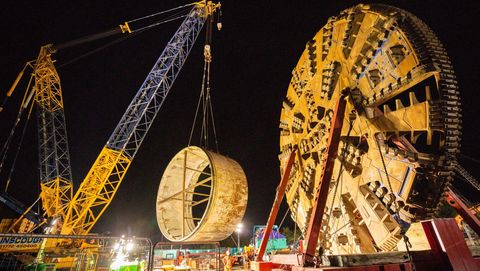Members
VINCI: Leading the way towards net zero in construction

For its exemplar work to decarbonise its operations, VINCI Construction Grands Projets picked up a win in the Net Zero Champion category at last year’s Franco-British Business Awards
At VINCI, acting to protect the environment is now the number-one concern uniting all aspects of company strategy and operations.
Since launching its Environmental Ambition in 2020, VINCI has built up a company culture of sustainability by directly involving employees in developing new ideas. VINCI’s projects in the UK, France and around the world offer a leading example on developing climate-resilient infrastructure, reducing on-site emissions, preserving the natural environment and maximising opportunities for reducing and reusing raw materials.

Getting ahead on climate: the infrastructure of tomorrow
Businesses are now starting to put their environmental plans into action – but for VINCI, merely adapting to the effects of climate change is not enough. Instead, businesses need to ‘get ahead’ – particularly since the built environment is responsible for 40% of global carbon emissions.
This means building with climate-related risks in mind. The infrastructure of the future needs to be built to withstand the risks of a changing climate – whether that be from flooding, heat, fire or wind.
At the same time, rapid action is needed to decarbonise. By 2030, VINCI’s target is to have cut its scope 1 and 2 emissions by 40% and its scope 3 emissions by 30%. VINCI’s progress to date is well ahead of its initial trajectory, with an 8% reduction in scope 1 and 2 emissions achieved between 2018 and 2021.
By 2030, VINCI also aims to use 90% low-carbon concrete in its projects – an area which it has pioneered through its Exegy concrete range, which has been shown to achieve a carbon reduction of up to 70% compared to traditional cement.
As company Environment Director Isabelle Spiegel puts it, the best way to approach the climate crisis is to see it “less of a constraint than as an opportunity to renew our approach to business”.
Industry best practice on carbon reduction
To get to net zero within the construction industry, emissions need to be cut at all stages of the building process, including the design and construction stages. This includes designing out carbon, new working practices, new methods and using new technology as it becomes available, and also through changing behaviours on site. VINCI’s initiatives on its UK projects are helping to set the industry standard on this.
In London, VINCI is one of three contractors working on the eastern section of the Thames Tideway Tunnel, a project to expand London’s Victorian sewer network. Currently, just 2mm of rainfall is enough to result in raw sewage being discharged into the River Thames. After its completion in 2025, the new tunnel will catch the vast majority of this overflow and help to clean up the river for generations to come.
Several dedicated campaigns on the eastern section of the Tideway project have prevented the generation of over 50,000 tonnes of carbon dioxide.
Last year, for example, an anti-idling campaign led to a 15% reduction in vehicle emissions over a one-month period. Converting site fuel to hydrotreated vegetable oil (HVO) fuel rather than diesel has also saved over 880 tonnes in carbon emissions – equivalent to savings from growing 13,500 tree seedlings for 10 years.
A ‘More By River’ strategy, prioritising the use of river transport to deliver and remove materials to construction sites, has also helped to take more than 44,000 lorries off London’s roads – reducing both carbon emissions and traffic congestion.
VINCI is also involved in the construction of the 2024 Athletes’ Village in Paris, which will be built entirely using bio-sourced materials and low-carbon concrete.

The lab recherche environnement: keeping industry linked to science
Best practice on the environment means keeping abreast of the latest scientific research on the topic – something VINCI has been doing for 15 years through the lab recherche environnement.
Together with the ParisTech engineering schools, VINCI has co-sponsored this initiative since 2008. The lab supports research on the environmental performance of buildings, infrastructure and communities. Research from the lab is then made public and shared with both the scientific community and key stakeholders.
A €5m investment by VINCI in 2020 has enabled the lab to expand its research into areas like energy efficiency, sustainable mobility, and diversity – helping to ensure that VINCI can sustain its commitment to low-carbon construction well into the future.
